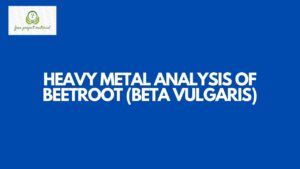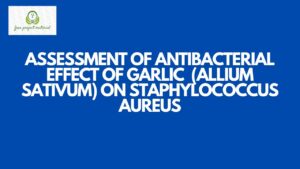ABSTRACT
The aim of this study is to carry out characterization and identification of bacteria associated with sputum. Standard Aseptic methods were used for the bacteriological analysis. A total of two sample were analyzed and was labeled as sample A and sample B, the highest bacterial count was observed in sample A with 3.6 x 104 a total of four isolate were obtained, these were staphylococcus sp., Streptococcus, Proteus sp. and E. coli., the highest percentage occurrence was observed in Staphylococcus aureaus (64%) while the least was E. coli., (10%) this shows that the sputum habours some pathogenic organism and as such it is recommenced that its disposal expellation should be done properly and not careless in order to prevent the spreading of pathogenic microorganism.
TABLE OF CONTENTS
Tile Page – – – – – – – – i
Certification – – – – – – – – ii
Dedication – – – – – – – – iii
Acknowledgements – – – – – – iv
Abstract – – – – – – – – v
Table of Contents – – – – – – – vi-viii
CHAPTER ONE: INTRODUCTION
1.1 Background of the study – – – – – 1-4
1.2 Aim and Objectives – – – – – – 5
1.3 Scope and Limitation of the study – – – – 5
1.4 Definition of Terms – – – – – – 5
CHAPTER TWO: LITERATURE REVIEW
2.1 Existing Intrusion Detection System – – – 6-7
2.2 Intruder Alarm System – – – – – 7-8
2.3 Intrusion Detectors – – – – – – 8-9
2.3.1 PIR (Passive Infrared motion detectors) – – – 9-12
2.3.2 PET (Pet Immune motion detectors) – – – – 12-13
2.3.3 Dual Technology Detectors – – – – – 13-16
2.3.4 Magnetic Contact – – – – – – – 16-17
2.3.5 Acoustic Glass Break Detectors – – – – – 17-18
2.3.6 Vibration/Chock Sensors – – – – – – 18
2.4 External Alarm Sounder – – – – – – 18-20
2.5 Hardware Alarm Circuit Configuration – – – 20
2.5.1 Single NC and single NO circuits – – – – 21-22
2.5.2 EOLR – – – – – – – – 22-23
2.5.3 DEOLE – – – – – – – – 23
2.6 Intruder Alarm Functions – – – – – – 24-26
2.7 Basic Intruder Alarm Rules – – – – – 26-28
CHAPTER THREE: MATERIALS AND METHOD
3.1 Materials – – – – – – – – 29
3.2 Method – – – – – – – – – 29-31
CHAPTER FOUR: RESULTS AND DISCUSSION
4.1 Results – – – – – – – – – 32
4.2 Discussion – – – – – – – – 32-33
CHAPTER FIVE: SUMMARY CONCLUSION AND RECOMMENDATION
5.1 Summary – – – – – – – – 34
5.2 Conclusion – – – – – – – – 35
5.3 Recommendation – – – – – – – 35-36
References
CHAPTER ONE
Introduction
1.1 Background of the study
Sputum microscopy and culture are commonly used for diagnosing the cause of pneumonia in adults but are rarely performed in children due to difficulties in obtaining the specimen. Induced sputum is occasionally used to investigate lower respiratory infections in children but has not been widely in pneumonia etiology studies (Harju et al., july 2006). Lower respiratory tract infections (LRTIs) are common infections in the general population, however older individuals and patients with chronic diseases or compromised immune functions are prone to these infections (Burns et al., may 2012) . Lower respiratory tract infections account for a greater burden of disease worldwide than ischaemic heart disease, cancer, malaria or human immune deficiency virus infection so managing patients with LRTIs is a great challenge to the clinician (Joseph P. Mizgerd SD, 2008) and still more, with increasing antimicrobial resistance. Its empirical treatment may vary according to the type of causative organisms. The objective of this study is to identify the pathogenic micro-organisms and their antimicrobial susceptibility pattern from sputum sample. Different societies like the British Thoracic Society (BTS) and infectious Disease society of America (IDSA) have formulated the main guidelines on managing LRTLs ( Lim WS, et al., 2009). The identification of pathogenic organisms causing LRTLs is very important for treatment (Mandel LA, et al., 2007). The most common pathogens isolated from sputum samples are Klebsiella pneumonia (39.5%) followed by pseudomonas (25%), Escherichia coli (11.5%), Staphylococcus (11.5%) and others (3.8%) (Asati RK. Antimicrobial sensitivity pattern of Klebsiella pneumonia isolated from sputum (2013).
1.2 Aim and Objective
1.2.1 Aim of the Study
The aim of this research work is to identify and characterized the bacteria associated in sputum.
1.2.2 Objective of the study
The objective of this research work is to;
- The objective of this study was to identify the pathogenic micro-organisms and their antimicrobial susceptibility pattern from the sputum sample.
1.3 Scope and Limitation
The research focuses on the characterization of antimicrobial and antibacterial organisms found in sputum. Taking into consideration time, space, and financial constraints, it will not be possible for the researcher to get as many different sputum sample, the student will narrow down to dust one sample collection.


